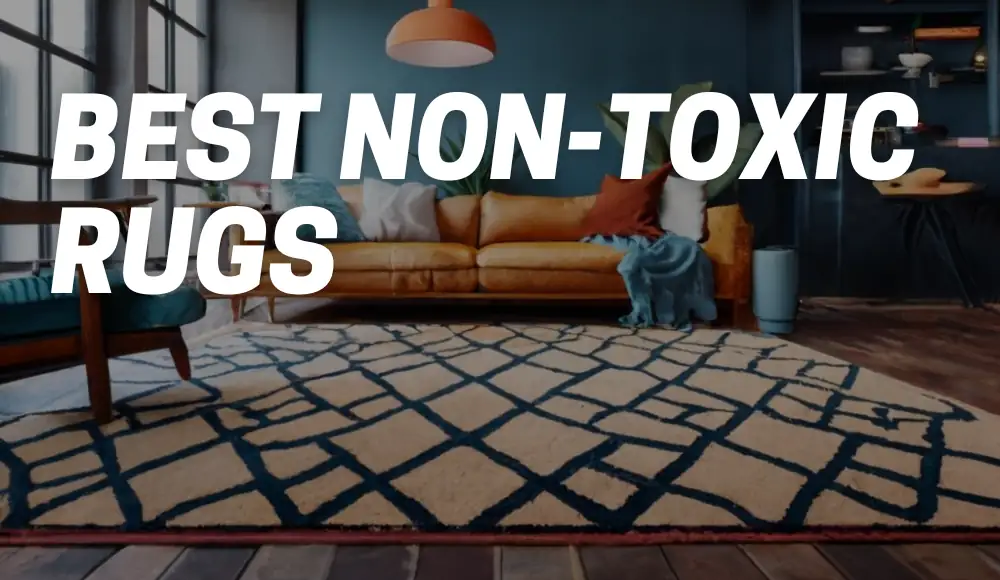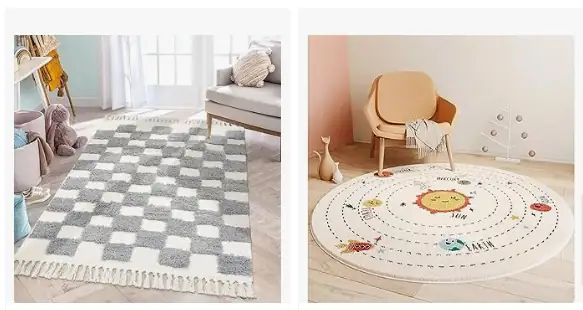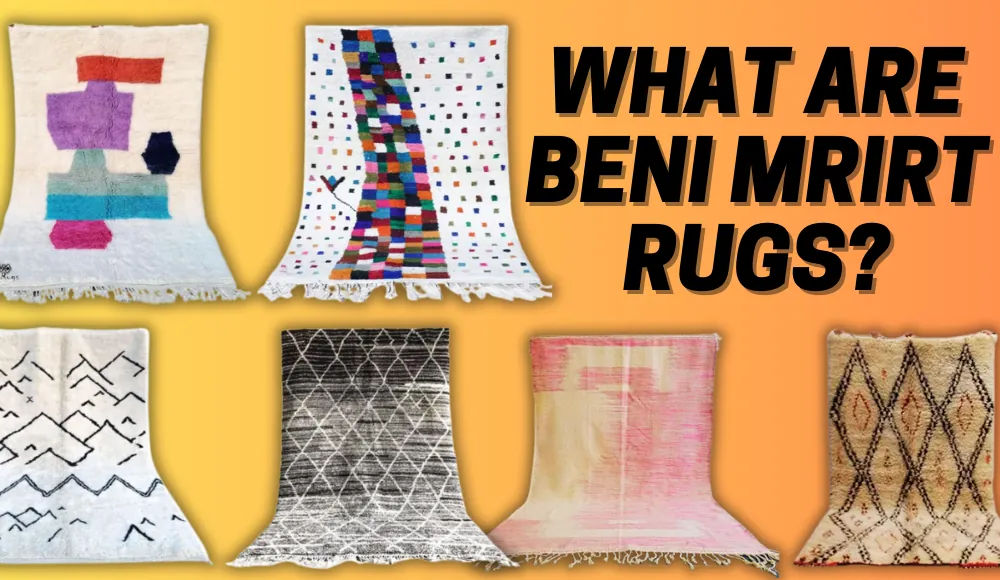Last updated on October 28th, 2023 at 01:03 pm
When it comes to creating a safe and healthy living environment, choosing the right materials for your home is paramount. One often-overlooked element is the humble rug, which can harbor a surprising array of toxins and chemicals. In this guide, we’ll explore the world of non-toxic rugs, helping you make informed decisions to safeguard your home and loved ones.
What Are Non-Toxic Rugs?
Non-toxic rugs are floor coverings made from materials that are free from harmful chemicals and toxins. These rugs are designed to be environmentally friendly and safe for human health. Unlike traditional rugs, which may contain synthetic materials, adhesives, or dyes that emit volatile organic compounds (VOCs), non-toxic rugs are made from natural, sustainable, and eco-friendly materials.
Non-toxic rugs can be a healthier choice for your home for several reasons:
1. Improved Indoor Air Quality
Non-toxic rugs release minimal or no VOCs, which means they won’t pollute the indoor air in your home. This is especially important for individuals with allergies, asthma, or chemical sensitivities, as it reduces the risk of respiratory issues and other health problems.
2. Environmentally Friendly
These rugs are often made from sustainable materials like organic cotton, natural fibers, and other eco-friendly options, reducing the ecological impact of their production.
3. Safer for Children and Pets
Non-toxic rugs are ideal for families with young children and pets who spend a lot of time playing on the floor. You can rest assured that your loved ones aren’t exposed to harmful substances.
How to Identify Non-Toxic Rugs
Identifying non-toxic rugs when shopping can be challenging, as not all manufacturers clearly label their products as “non-toxic.” To help you make an informed decision, consider the following tips:
- Check the Materials: Look for rugs made from natural materials like wool, organic cotton, jute, seagrass, or bamboo. These materials are less likely to contain harmful chemicals.
- Certifications: Look for certifications like Oeko-Tex Standard 100, which ensures that the rug materials are free from harmful substances. Additionally, certifications such as Global Organic Textile Standard (GOTS) and Fair Trade are good indicators of environmentally friendly and ethical production.
- Manufacturing Processes: Research the manufacturer’s information to determine if they use eco-friendly and non-toxic dyes and adhesives in the rug-making process.
- Customer Reviews: Read reviews from other consumers who have purchased the rug. They may provide insights into the rug’s quality, safety, and durability.
What Is The Least Toxic Rug Material
If you’re searching for the least toxic rug materials, here are some options to consider:
- Wool: Wool rugs are natural, durable, and resistant to dust mites and bacteria. They are a great choice for non-toxic living spaces.
- Organic Cotton: Organic cotton rugs are made from pesticide-free cotton and are a sustainable and non-toxic choice.
- Jute and Seagrass: These natural fibers are durable and free from harmful chemicals, making them excellent options for non-toxic rugs.
- Bamboo: Bamboo rugs are eco-friendly, hypoallergenic, and resistant to moisture, making them a safe choice for homes.
Where Can I Buy Non-Toxic Rugs?
Finding non-toxic rugs can be challenging, but there are several reputable stores, websites, and brands that offer these eco-friendly options:
- Earth Weave: Earth Weave offers a variety of non-toxic, chemical-free rugs made from natural materials.
- Coyuchi: Known for their organic bedding, Coyuchi also offers non-toxic rugs made from sustainable materials.
- Local and Online Eco-Stores: Many eco-friendly stores, both brick-and-mortar and online, carry non-toxic rug options. Always check the product descriptions for materials and certifications.
- Retailers: Niche-specific retailers and the big online marketplaces, such as Amazon, Etsy, etc.
Are IKEA Rugs Non-Toxic?
IKEA, a popular furniture retailer, has made strides in offering eco-friendly and non-toxic products. Some of their rugs are made from sustainable materials and may be considered non-toxic. However, it’s essential to check the specific rug’s materials and certifications to determine its safety.
Here’s the official information presented on the IKEA site:
| Topic | IKEA’s Actions |
|---|---|
| Chemical Substances Phased Out in Textiles | – Chlorine for bleaching: Banned since 2005. – Bans on certain dyestuffs, e.g., disperse dye, direct dye, basic dye, or azo dyes, known to be carcinogenic or allergenic. – PVC: Banned since 1991. – Formaldehyde: Banned since 1991 in textile products. – APEO: Banned since 2002 against the usage of chemicals containing APEO (NPEO and OPEO). – Organic solvents: Banned since 1998. – Flame retardants used only when required by legislation in certain markets; brominated flame retardants banned since 1998. – PFAS (per- and polyfluoroalkyl substances): Banned in textiles since 2016. |
| IKEA’s Compliance Verification | All IKEA products go through a thorough testing process before being put on the market. In order to secure compliance to the requirements, IKEA does regular verifying tests both on material and final products. IKEA also carries out random checks and audits. |
| IKEA’s Policy on Pesticide Usage | Yes. IKEA was a founding member of the Better Cotton Initiative (BCI) and takes an active role in the work. Since August 2015, all cotton used for IKEA products is Better Cotton and compliant with BCI social and environmental criteria. |
Benefits of Using Non-Toxic Rugs
Using non-toxic rugs in your home comes with numerous advantages:
- Better Indoor Air Quality: Non-toxic rugs help maintain clean and healthy indoor air, reducing the risk of respiratory issues and allergies.
- Sustainability: Supporting sustainable materials and ethical manufacturing processes contributes to a healthier planet.
- Safety for Children and Pets: Non-toxic rugs are safe for the whole family, including children and pets, who often spend a lot of time on the floor.
Are Non-Toxic Rugs More Expensive?
Non-toxic rugs can be more expensive than conventional rugs due to the higher cost of using sustainable materials and eco-friendly manufacturing processes. However, the investment is worth it, considering the long-term benefits for your health and the environment.
To compare prices and find the best value for non-toxic rugs, it’s advisable to research different brands, materials, and retailers.
Reviews and Recommendations for Non-Toxic Rug Brands
Here’s a table summarizing the main points from the user comments regarding reviews and recommendations for non-toxic rug brands:
| Rug Brand | Material Composition | Features and Recommendations |
|---|---|---|
| West Elm | Wool | Wool rugs are comfy and may shed but considered safe. |
| Hook & Loom | Cotton | Cotton rug is tidy-looking and suitable for a baby. |
| Hook & Loom | Cotton | Cotton rugs are plush, gorgeous, easy to vacuum. |
| Second-hand or 100% wool | 100% wool, organic or second-hand quilt | Recommends 100% wool or wool/cotton/sisal blend. |
| IKEA, 100% wool | 100% wool | IKEA offers affordable, washable 100% wool rugs. |
| IKEA | 100% cotton | Recommends 100% cotton for its safety and washability. |
| Wool carpet offcut | Wool | Uses wool carpet offcut, soft and not prone to shedding. |
| Wool rug with muslin blankets | Wool with muslin on top | Uses wool rug with muslin blankets for comfort and washability. |
| IKEA (SKAMSTRUP) | 80% wool, 20% nylon | Chooses an 80% wool rug with a small amount of nylon. |
| Loloi rugs (Amazon) | Recycled materials, vegetable dyes | Likes Loloi rugs for being non-toxic and dyed naturally. |
| Braided yarn wool rugs | Wool | Recommends wool braided yarn rugs, non-shedding. |
| Latex and polyester rug | Latex, polyester, OEKO-TEX certified | Prefers an OEKO-TEX certified rug with latex and polyester. |
Please note that the recommendations are based on individual preferences and experiences, so the choice of a non-toxic rug ultimately depends on personal priorities and needs.
How to Clean and Maintain Non-Toxic Rugs
Proper care and maintenance can extend the lifespan of your non-toxic rug:
- Regular Vacuuming: Vacuum your rug to remove dust, dirt, and debris. Be sure to use a vacuum cleaner with a HEPA filter for improved air quality.
- Spot Cleaning: Address spills and stains promptly using a mixture of mild detergent and water. Avoid harsh chemical cleaners.
- Rotate Your Rug: To prevent uneven wear, rotate your rug periodically, especially in high-traffic areas.
- Use Rug Pads: Place a non-slip, non-toxic rug pad under your rug to prevent slipping and protect your floors.
What Rugs Are Safe for Babies and Nurseries?
Non-toxic rugs are an excellent choice for baby nurseries and playrooms. They provide a safe and healthy environment for your little ones. Look for rugs made from organic cotton or wool, as these materials are hypoallergenic and gentle on sensitive skin.
Here’s a table summarizing the main points from the comments about the best non-toxic rugs for nurseries:
| Key Points |
|---|
| Wool is recommended for being non-toxic, non-flammable, and long-lasting with proper care. |
| Wool rugs may shed initially but are great after frequent vacuuming. Suggests using thick pads underneath. |
| IKEA offers great wool area rugs, affordable options. |
| Found a 100% wool rug at IKEA for under $100 that has held up well, plush and soft. |
| Recommends the DII Contemporary Reversible Indoor Area Rag Rug, machine washable and suitable for various rooms. |
| Recommends purchasing rugs from fabhabitat.com. |
| Admires washable rugs from lorenacanals.com. |
| Highlights the durability of a dark brown woven wool rug from IKEA, suitable for nursery use. |
| Recommends getting a wool rug from overstock.com or rugusa.com. |
| Suggests checking Tuesday Morning for affordable and good-quality wool rugs. |
| Recommends natural sheepskins but cautions about the importance of knowing the source and processing of wool products. Emphasizes avoiding wool products processed with chemicals. |
Comparing Non-Toxic Rugs to Traditional Rugs
Let’s compare non-toxic rugs to their traditional counterparts:
Materials
- Non-Toxic Rugs: Made from natural and sustainable materials like organic cotton, wool, and jute.
- Traditional Rugs: Often contain synthetic materials, adhesives, and dyes that emit VOCs.
Durability
- Non-Toxic Rugs: Typically durable and long-lasting due to high-quality materials.
- Traditional Rugs: Durability may vary depending on the quality of materials used.
Environmental Impact
- Non-Toxic Rugs: Have a lower environmental impact due to sustainable materials and eco-friendly production.
- Traditional Rugs: May contribute to pollution and resource depletion.
DIY Non-Toxic Rug Options
If you’re feeling creative and want to ensure your rug is non-toxic, consider making your own. Here’s a simple DIY option using natural materials:
Materials:
- Natural fabric such as organic cotton or burlap
- Non-toxic dye
- Natural rubber for backing
Steps:
- Cut the fabric to your desired rug size.
- Use non-toxic dye to add color and designs to the fabric.
- Attach a natural rubber backing for grip and stability.
Certifications and Labels for Non-Toxic Rugs
When shopping for non-toxic rugs, look for these common certifications and labels:
- Oeko-Tex Standard 100: Ensures the rug materials are free from harmful substances.
- GOTS (Global Organic Textile Standard): Indicates organic and eco-friendly production.
- Fair Trade: Suggests ethical and fair labor practices in rug manufacturing.
In conclusion, choosing the best non-toxic rugs for your home is a significant step toward creating a healthier and safer living environment. By understanding what makes a rug non-toxic, where to find them, and how to maintain them, you can enjoy the benefits of clean indoor air, eco-friendliness, and peace of mind for you and your family.
For further information, you can refer to authoritative sources such as the Environmental Protection Agency (EPA) and the American Lung Association.
Remember, your choice of a non-toxic rug isn’t just about decorating your home; it’s about creating a healthier and safer space for everyone who lives there.


